Garmin 01891 LOW POWER TRANSMITTER (2400-2483.5 MHz) User Manual 1
Garmin International Inc LOW POWER TRANSMITTER (2400-2483.5 MHz) Users Manual 1
Garmin >
Contents
- 1. Users Manual 2
- 2. Users Manual 1
Users Manual 1
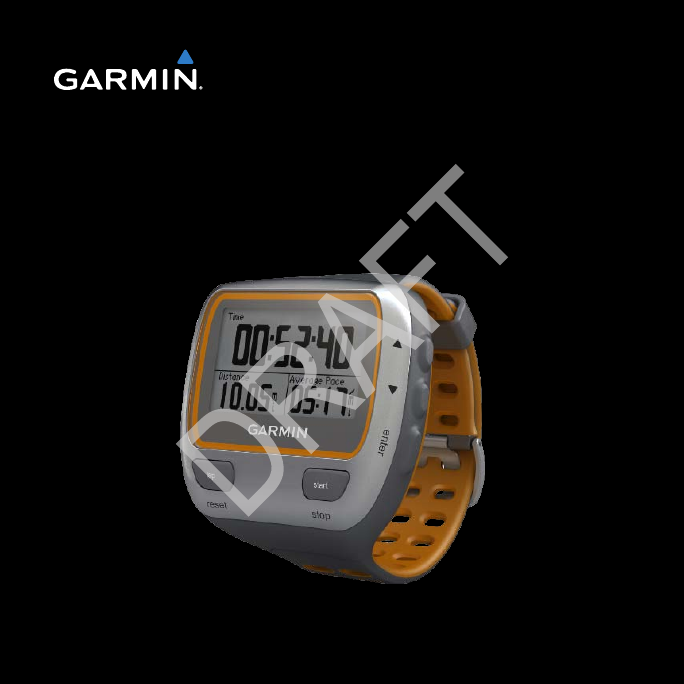
MULTISPORT GPS TRAINING DEVICE
190-01371-00 Rev. A Printed in Taiwan

© 2011 Garmin Ltd. or its subsidiaries
All rights reserved. Under the copyright laws, this manual may not be copied, in whole or in part, without the
written consent of Garmin. Garmin reserves the right to change or improve its products and to make changes
in the content of this manual without obligation to notify any person or organization of such changes or
improvements. Go to www.garmin.com for current updates and supplemental information concerning the use
of this product.
Garmin
®
, the Garmin logo, Forerunner
®
, Virtual Partner
®
, Auto Pause
®
, and Auto Lap
®
are trademarks of
Garmin Ltd. or its subsidiaries, registered in the USA and other countries. GSC
™
, Garmin Connect
™
, Virtual
Racer
™
, USB ANT Stick
™
, ANT
™
, and ANT+
™
are trademarks of Garmin Ltd. or its subsidiaries. These
trademarks may not be used without the express permission of Garmin.
Firstbeat and Analyzed by Firstbeat are registered or unregistered trademarks of Firstbeat Technologies Ltd.
New Leaf
®
is a registered trademark of the Angeion Corporation. Other trademarks and trade names are those
of their respective owners.

Forerunner x10XT Owner’s Manual 3
Introduction
About the Battery ....................... 5
Setting Up the Device ................ 5
Registering Your Device ............ 5
Getting More Information ........... 5
Getting Started (QSM) Charging
the Battery ............................... 6
Turning on the Device ............... 6
Keys........................................... 7
Locating Satellite Signals ...........
Sport Mode ................................ 8
Going for a Run ......................... 8
Saving Your Run ........................ 9
Run Options............................... 9
Interval Workouts ..................... 14
Custom Workouts .................... 16
Bike Training Options .............. 18
Swimming with Your
Forerunner ............................ 19
Using the Countdown Timer .... 19
Pairing Your ANT+ Sensors ..... 22
Heart Rate Monitor .................. 23
Foot Pod .................................. 25
GSC 10 .................................... 26
Using the Weight Scale ........... 27
Fitness Equipment ................... 27
Heart Rate Zone
Calculations .......................... 28
ANT+ Sensor
Troubleshooting .................... 29
Viewing History ........................ 30
Deleting History ....................... 31
Using Free Software ................ 31
Sending History to Your
Computer ............................. 32

4 Forerunner x10XT Owner’s Manual
Introduction
Locations ................................. 33
Navigating to a Saved
Location ................................ 33
Navigating Back to Start .......... 34
Stopping the Navigation .......... 34
GPS Settings ........................... 34
System Settings....................... 35
Time Settings ........................... 36
Setting Your User Prole ......... 36
Customizing the Training
Pages .................................... 37
Specications .......................... 43
About the Battery ..................... 45
Heart Rate Monitor Battery ...... 47
Changing the Wrist Band ......... 48
Caring for Your Device............. 49
Updating the Software Using
Garmin Connect .................... 50
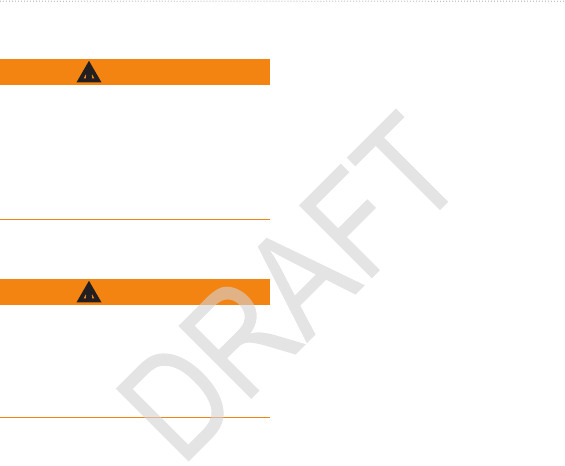
Forerunner x10XT Owner’s Manual 5
Introduction
Always consult your physician before
you begin or modify any exercise
program. See the Important Safety
and Product Information guide in the
product box for product warnings and
other important information.
This product contains a lithium-ion
battery. See the Important Safety and
Product Information guide in the
product box for product warnings and
other important information.
The device is powered by a built-in,
lithium-ion battery that you can charge
using the charger included in the
product box (page 49).
When using your Forerunner®
the rst time, follow the setup
instructions in the Forerunner
910XT Quick Start Manual.
Help us better support you by
completing our online registration
today.
• Go to http://my.garmin.com.
• Keep the original sales receipt, or a
photocopy, in a safe place.
• Go to www.garmin.com/intosports.
• Go to www.garmin.com
/learningcenter.
• Go to http://buy.garmin.com,
or contact your Garmin dealer
for information about optional
accessories and replacement parts.
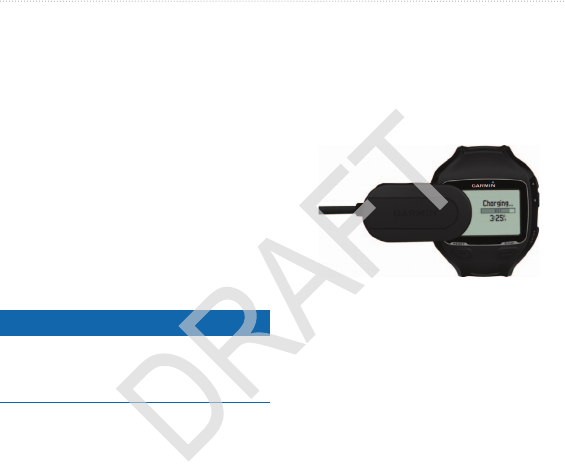
6 Forerunner x10XT Owner’s Manual
Introduction
When using your Forerunner the rst
time, complete these tasks.
1. Charge the Forerunner ().
2. Turn on the Forerunner ().
3. Put on the optional heart rate
monitor ().
4. Go for a run ().
5. Save your run ().
notice
To prevent corrosion, thoroughly dry
the contacts and the surrounding area
before charging.
1. Plug the USB connector on the
charging clip cable into the AC
adapter.
2. Plug the AC adapter into a standard
wall outlet.
3. Align the charging clip posts with
the contacts on the back of the
Forerunner.
4. Clip the charger securely over the
face of the Forerunner.
5. Charge the Forerunner completely.
A fully charged battery will last up to
20 hours, depending on usage.
The rst time you use the Forerunner,
you are prompted to choose your
system settings and enter user prole
information.
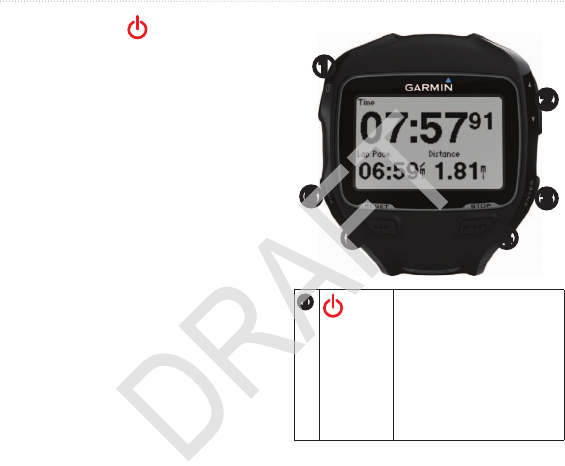
Forerunner x10XT Owner’s Manual 7
Introduction
1. Press and hold to turn on your
Forerunner.
2. Follow the on-screen instructions.
3. Go outdoors to an open area.
4. Wait while the Forerunner searches
for satellites.
It may take 30–60 seconds to locate
satellite signals. Do not begin your
activity until the locating satellites
banner disappears.
The time of day and date are set
automatically.
➊
➋
➌
➍➎
➏
➊
Hold
to turn the device
on and off.
Select to turn on the
backlight.
Select to search for
a compatible weight
scale.
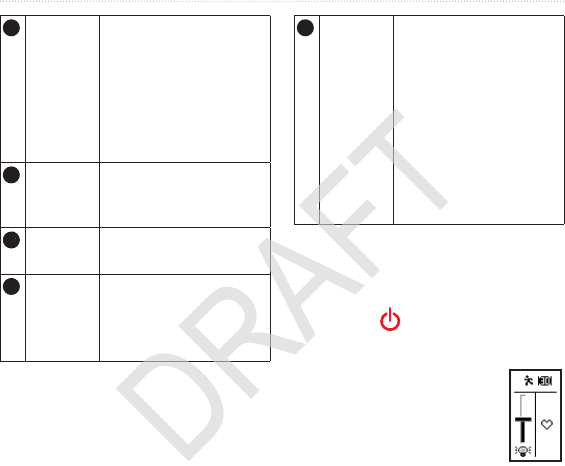
8 Forerunner x10XT Owner’s Manual
Introduction
➋
Select to scroll through
menus and settings.
Hold to scroll quickly
through the settings.
Select to scroll through
training pages during a
workout.
➌
Press to select options
and to acknowledge
messages.
➍
Select to start and stop
the timer.
➎
Select to mark a new
lap.
Hold to save your run
and reset the timer.
➏
Select to view the timer
and the menu. The
map and the compass
also appear if they are
active.
Select to exit a menu or
a page. Your settings
are saved.
Hold to switch sport
modes.
➊
power
• Press and hold to turn the
Forerunner on and off.
• Press to turn on and to
adjust the backlight. A
status page appears.
• Press to pair with your
ANT+™ weight scale (page 34).
•
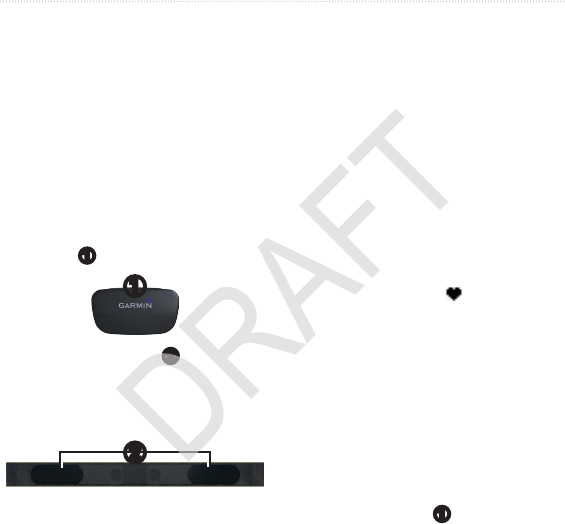
Forerunner x10XT Owner’s Manual 9
Introduction
NOTE: If you do not have a heart rate
monitor, you can skip this task.
Wear the heart rate monitor directly on
your skin, just below your breastplate.
It should be snug enough to stay in
place during your run.
1. Connect the heart rate monitor
module
➊
to the strap.
➊
2. Wet both electrodes
➋
on the
back of the strap to create a strong
connection between your chest and
the transmitter.
➋
3. Wrap the strap around your chest,
and connect it.
The Garmin logo should be right-
side up.
4. Bring the device within range (3 m)
of the heart rate monitor.
TIP: If the heart rate data is erratic
or does not appear, you may have
to tighten the strap on your chest or
warm up for 5–10 minutes.
After you put on the heart rate monitor,
it is on standby and ready to send data.
When the heart rate monitor is paired, a
message appears, and appears solid
on the screen.
Before you can record history, you
must locate satellite signals () or pair
your Forerunner with an optional foot
pod.
1. From the timer page, select START
to start the timer
➊
.

10 Forerunner x10XT Owner’s Manual
Your Training
This section describes training features
and settings for your device.
• Run basics (pages 10–10)
• Bike basics ()
• Swim basics ()
• Multi sport setup ()
• Alerts (page 11)
• Auto Lap® (page 12)
• Auto Pause® (page 13)
• Auto scroll (page 14)
• Virtual Partner® (page 14)
• Virtual Racer™ (page 15)
• Interval workouts (page 16)
• Custom workouts (page 17)
Press and hold mode to change the
sport mode. All settings are specic to
the current sport that you have selected.
1. Select MODE > Settings > Run
Settings > Pace/Speed > Pace/
Speed.
2. Select Pace or Speed.
This setting controls the data shown
on the following pages: Virtual
Partner, history, custom workouts,
courses, and Auto Pause.
For a complete list of the available
data elds and descriptions, see
page 42.

Forerunner x10XT Owner’s Manual 11
Your Training
NOTE: Alerts do not function during
interval or custom workouts.
You can use alerts to train toward
specic time, distance, calorie, heart
rate, and cadence goals.
NOTE: To turn on alert tones and
vibrations, see page 39.
1. Select MODE > Training > Run
Alerts.
2. Select Time Alert, Distance Alert,
or Calorie Alert.
3. Select On.
4. Select Alert At, and enter a time,
distance, or calorie amount.
Each time you reach the alert amount,
the device beeps and displays a
message.
If you have an optional heart rate
monitor, foot pod, or GSC™ 10, you
can set up advanced alerts for heart rate
and cadence.
1. Select MODE > Training >
Options > Run Alerts.
2. Select an option:
• Select HR Alert to set the high
and low heart rate values in
beats per minute (bpm).
NOTE: For more information
about heart rate zones,
see page 25.
• Select Cadence Alert to set the
high and low cadence amounts
in steps per minute (spm) or
revolutions of the crank arm per
minute (rpm).
3. Set the parameters for your heart
rate or cadence alerts.

12 Forerunner x10XT Owner’s Manual
Your Training
Each time you exceed or drop below
the specied heart rate or cadence
amount, the device beeps and displays
a message.
Some running programs use timed
walking breaks at regular intervals.
For example, during a long training
run, the program may instruct you to
run for four minutes, then walk for 1
minute, and repeat. Auto Lap functions
correctly while you are using the run/
walk alerts.
1. Select MENU > Training > Run
Alerts.
2. Select Run/Walk > Run/Walk
Alert > On.
3. Select Run Alert, and enter a time.
4. Select Walk Alert, and enter a
time.
Each time you reach the alert amount,
the device beeps and displays a
message. The run/walk alerts will
repeat until you stop the timer.
The default Auto Lap setting is By
Distance, 1 mile or 1 kilometer.
NOTE: Auto Lap does not function
during interval or custom workouts.
You can use Auto Lap to automatically
mark the lap at a specic distance. This
feature is helpful for comparing your
performance over different parts of a
run.
1. Select MENU > Settings > Run
Settings > Auto Lap.
2. Select Auto Lap Trigger > By
Distance.
3. Select Lap At, and enter a distance.

Forerunner x10XT Owner’s Manual 13
Your Training
You can use Auto Lap to automatically
mark the lap at a specic position. This
feature is helpful for comparing your
performance over different parts of a
run (for example, a long hill or training
sprints).
1. Select MENU > Settings > Run
Settings > Auto Lap.
2. Select Auto Lap Trigger > By
Position > Lap At.
3. Select an option:
• Select Lap Press Only to
trigger the lap counter each time
you select LAP and each time
you pass any of those positions
again.
• Select Start and Lap to
trigger the lap counter at the
GPS location where you select
START and at any location
during the run where you select
LAP.
• Select Mark and Lap to trigger
the lap counter at a specic GPS
location marked before the run
(use Mark Position) and at any
location during the run where
you select LAP.
NOTE: Auto Pause does not function
during interval or custom workouts.
You can use Auto Pause to pause the
timer automatically when you stop
moving or when your speed drops
below a specied value. This feature is
helpful if your run includes stop lights
or other places where you need to slow
down or stop.
NOTE: The paused time is not saved
with your history data.
1. Select MENU > Settings > Run
Settings > Auto Pause.
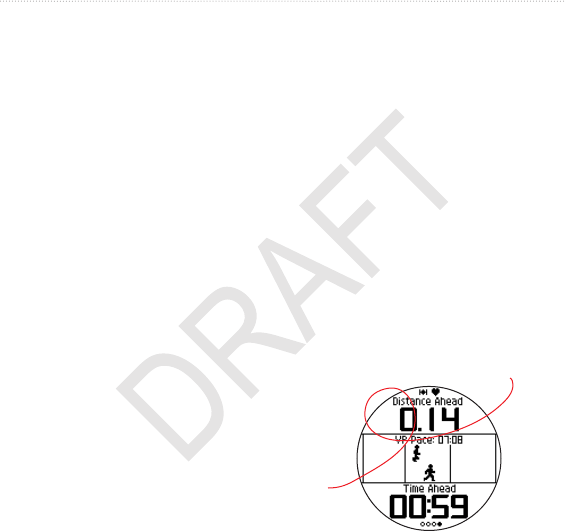
14 Forerunner x10XT Owner’s Manual
Your Training
2. Select an option:
• To pause the timer automatically
when you stop moving, select
When Stopped.
• To pause the timer automatically
when your speed drops below a
specied value, select Custom
Speed.
You can use the auto scroll feature to
automatically cycle through all of the
training data pages while the timer is
running.
1. Select MENU > Settings > Run
Settings > Auto Scroll.
2. Select Slow, Medium, or Fast.
Your Virtual Partner is a training tool
designed to help you meet your goals.
1. Select MENU > Training >
Virtual Partner.
2. Select Virtual Partner > On.
3. Select Format, and select Speed or
Pace.
4. Enter a value for the Virtual
Partner’s speed or pace.
5. Select Alert > On (optional).
6. Go for a run.
7. Scroll to the Virtual Partner page to
see who is leading.

Forerunner x10XT Owner’s Manual 15
Your Training
Your Virtual Racer is a training tool
designed to help you improve your
performance. You can race against
your own activity or one transferred
from your computer (page 15). For
example, you can practice running the
actual race route and save it to your
Forerunner. On race day, you can race
against that practice run. The Virtual
Racer pushes you to beat your previous
pace including hills where you might
slow down and the nal sprint to the
nish line.
Before you can create a race, you must
have at least one saved activity.
1. Select MENU > Training >
Virtual Racer.
2. Select Create New Race, and
select an activity from the list.
3. Enter a name.
4. Select the race.
5. Select Do Race.
Select MENU > Training > Virtual
Racer, and select a race.
• View Stats—Displays the time and
distance of the previous activity.
• Race Options—Allows you to edit
the race name, delete the race, and
set alert tones.
You must have a Garmin Connect
account (page 35).
Before you can wirelessly send an
activity to your device, you must pair
the Forerunner with your computer
using the USB ANT Stick™ (page 36).
1. Pair the device to your computer.
2. Go to www.garminconnect.com,
and nd an activity.

16 Forerunner x10XT Owner’s Manual
Your Training
3. Click Send to Device.
4. On the device, Select MENU >
Training > Virtual Racer.
5. Select the race.
6. Select Do Race.
You can create interval workouts
based on distance or time. Your
custom interval workout is saved until
you create another interval workout.
Open intervals can be used for track
workouts when you are running a
known distance but want to keep
track of how many intervals you have
completed.
1. Select MENU > Training >
Workouts > Intervals.
2. Select Edit Workout.
3. Select Type, and select Time,
Distance, or Open.
TIP: To create an open-ended
interval, set the type to Open.
4. Enter a distance or time interval
value.
5. Select Rest Type, and select
Distance, Time, or Open.
6. If necessary, enter a distance or
time value for the rest interval.
7. Select the number of repetitions.
8. If necessary, select Warmup > Yes
to add an open-ended warmup to
your workout.
9. If necessary, select Cooldown >
Yes to add an open-ended cooldown
to your workout.

Forerunner x10XT Owner’s Manual 17
Your Training
1. Select MENU > Training >
Workouts > Intervals > Do
Workout.
2. Select START.
If your interval workout has a warm
up, you must select LAP to begin
the rst interval.
3. Follow the on-screen instructions.
When you complete all of the intervals,
a message appears.
• At any time, select LAP to end an
interval.
• At any time, select STOP to stop
the timer.
• If your interval workout has a cool
down, you must select LAP to end
the interval workout.
Custom workouts can include goals
for each workout step and varied
distances, times, and calories. You can
create custom workouts using Garmin
Connect® (page 35) and transfer them
to the Forerunner. However, you can
also create and save a custom workout
directly on your Forerunner.
You can also schedule custom
workouts using Garmin Connect. You
can plan workouts in advance and store
them on your Forerunner.

18 Forerunner x10XT Owner’s Manual
Your Training
1. Select MENU > Training >
Workouts > Custom > Create
New.
2. Select Run 000 to edit the name of
the workout.
3. Select Add New Step.
4. Select Duration to specify how the
step will be measured.
For example, select Distance to end
the step after a specic distance.
If you select Open, you can select
LAP to end the step during your
workout.
5. If necessary, select Duration
Value, and enter a value.
6. Select Target to choose your goal
during the step.
For example, select Heart Rate
to maintain a consistent heart rate
during the step.
7. If necessary, select a target zone or
enter a custom range.
For example, you can select a heart
rate zone. Each time you exceed
or drop below the specied heart
rate, the device beeps and displays
a message.
8. If necessary, select Rest Step >
Yes.
During a rest step, the timer
continues to run and data is
recorded.
9. If necessary, add another step to the
workout.
Before you can repeat a workout step,
you must create a workout with at least
one step.
1. Select Add New Step > Duration.
2. Select an option:
• Select Repeat to repeat a step
one or more times.

Forerunner x10XT Owner’s Manual 19
Your Training
For example, you can repeat a
1-mile step 4 times.
• Select Repeat Until to repeat a
step for a specic duration.
For example, you can repeat a
5-minute step for thirty minutes
or until you reach heart rate
zone 5.
3. Select Back to Step, and select a
step to repeat.
1. Select MENU > Training >
Workouts > Custom.
2. Select a workout, and select Do
Workout.
3. Select START.
4. Follow the on-screen instructions.
When you complete all of the steps, a
message appears.
• At any time, select LAP to end a
step.
• At any time, select STOP to stop
the timer.
1. Select MENU > Training >
Workouts > Custom.
2. Select the workout.
3. Select Delete Workout > Yes.
Before you can wirelessly send
workouts to your device, you must pair
the Forerunner with your computer
using the USB ANT Stick (page 36).
1. Connect the USB ANT Stick to
your computer.
2. Open Garmin Connect (page 35).
3. Follow the on-screen instructions.

20 Forerunner x10XT Owner’s Manual
Your Training
Many of the training features of the
Forerunner can be applied to cycling.
For the best results, you should
customize the cycling settings.
Your Forerunner can display data and
history for your bike training.
1. Hold MODE.
2. Select Bike.
After changing your sport, you can
set up alerts, Auto Lap, Auto Pause,
and Auto Scroll settings for your bike
training (pages 11–14).
For information about the
GSC™ 10, see page 28.

Forerunner x10XT Owner’s Manual 21
Other Training Features
Not sure what will be funneled into this
section.
The Forerunner is waterproof to
50 m for surface swimming. Use the
timer to record your swim time.
NOTE: The Forerunner records GPS
data only when you are swimming
outside using the freestyle stroke.
TIP: Because GPS signals may be
interrupted, swimmers and triathletes
should put the device in a swimming
cap, for the most-accurate speed and
distance data.
1. Press and hold mode > select
Other.
2. Press mode > select Settings >
Other Settings > Swim.
3. Select Enabled > Yes.
NOTE: The swim setting must be
turned on to get accurate distance
data.
4. Press start to start the timer.
5. When you have nished swimming,
press lap or stop to view your
distance and average speed in the
data elds.
You must press stop to stop the
timer.
NOTICE: Scuba diving with the
Forerunner may damage the product
and will void the warranty.
You can use the countdown timer to
automatically start the Forerunner
timer after a specied countdown. For

22 Forerunner x10XT Owner’s Manual
Other Training Features
example, you can use a 30-second
countdown before you start a timed
sprint. You can also set a 5-minute
countdown before starting a boat race.
NOTE: During the countdown, history
is not recorded.
The swim setting must be turned off to
access the countdown timer.
1. Press and hold mode > select
Other.
2. Press mode > select Settings >
Other Settings > Countdown
Timer.
3. Select Countdown Timer > On.
4. Enter the countdown time.
5. Press start to begin the countdown
timer.
You will hear 5 beeps before the
timer starts automatically.

Forerunner x10XT Owner’s Manual 23
Other Training Features

24 Forerunner x10XT Owner’s Manual
ANT+ Sensors
The Forerunner is compatible with
these ANT+ accessories.
• Heart rate monitor (page 25)
• Foot pod (page 27)
• GSC 10 (page 28)
• Power meters?
• Weight Scale (page 30)
• Fitness Equipment (page 30)
For information about purchasing
additional accessories, go to
http://buy.garmin.com.
Before you can pair, you must put on
the heart rate monitor or install the
sensor. See the quick start manual or
the accessory instructions.
If your Forerunner does not show
data from the accessory, you may
need to pair the accessory to your
Forerunner. Pairing is the connecting of
ANT+™ wireless sensors, for example,
connecting your foot pod with a
Forerunner. After you pair the rst
time, your Forerunner automatically
recognizes your foot pod each time it
is activated.
• Make sure that the ANT+ sensor
is compatible with your Garmin
device.
• Bring the Forerunner within range
(3 m) of the ANT+ sensor.
Stay 10 m away from other ANT+
sensors while pairing.
• If is off, select MODE >
Settings > Run Settings > Heart
Rate > HR Monitor > On >
Search for New.
• If is off, select MODE >
Settings > Run Settings > Foot
Pod > Foot Pod > On > Search

Forerunner x10XT Owner’s Manual 25
ANT+ Sensors
for New.
• If is off, Select MENU >
Settings > Bike Sensor > Bike
Sensor > On > Search for New.
• If you still cannot pair the
accessory, replace the accessory
battery (heart rate monitor,
page 49).
When the accessory is paired, a
message appears, and the accessory
icon (page 8) appears solid on the
screen.
Before you can customize your heart
rate zones, you must enable the heart
rate monitor.
The Forerunner uses your user prole
information from the initial setup to
determine your heart rate zones. For
the most accurate calorie data during
your activity, set your maximum heart
rate, resting heart rate, and heart rate
zones.
1. Select MODE > Settings > Run
Settings > Heart Rate > HR
Zones.
2. Enter you maximum heart rate.
If you do not know it, use 220 -
your age.
3. Enter your resting heart rate.
If you do not know it, select
Continue.
4. Select Zone Calc.
5. Select an option:
• Select Max. to view and edit the
zones as a percentage of your
maximum heart rate.
• Select Reserve to ...

26 Forerunner x10XT Owner’s Manual
ANT+ Sensors
• Select Custom to edit each zone
value manually.
The zone values update
automatically; however, you can
still edit each value manually.
Many athletes are using heart rate
zones to measure and increase their
cardiovascular strength and improve
their level of tness. A heart rate zone
is a set range of heartbeats per minute.
The ve commonly accepted heart
rate zones are numbered from 1 to
5 according to increasing intensity.
Generally, heart rate zones are
calculated based on percentages of
your maximum heart rate.
Knowing your heart rate zones can
help you measure and improve your
tness by understanding and applying
these principles.
• Your heart rate is a good measure of
exercise intensity.
• Training in certain heart rate
zones can help you improve
cardiovascular capacity and
strength.
• Knowing your heart rate zones can
prevent you from overtraining and
can decrease your risk of injury.
If you know your maximum heart
rate, you can use the table (page 32) to
determine the best heart rate zone for
your tness objectives.
If you do not know your maximum
heart rate, use one of the calculators
available on the Internet. Some gyms
and health centers can provide a test
that measures maximum heart rate.
• Heart rate alerts (page 11)
• Heart rate zone calculations
(page 32)

Forerunner x10XT Owner’s Manual 27
ANT+ Sensors
• Heart rate data elds (page 42)
• Heart rate troubleshooting
(page 33)
Your Forerunner is compatible with
the foot pod. You can use the foot pod
to send data to your Forerunner when
training indoors, when your GPS signal
is weak, or when you lose satellite
signals. The foot pod is on standby and
ready to send data. You must pair the
foot pod with your Forerunner
(page 24).
After 30 minutes of inactivity, the foot
pod powers off to conserve the battery.
When the battery is low, a message
appears on your Forerunner.
Approximately ve hours of battery
life remain.
If you plan to train outdoors, you can
set the Forerunner to use foot pod data
to calculate pace rather than using
GPS.
Select MODE > Settings > Run
Settings > Foot Pod > Speed
Source > Foot Pod.
Calibrating your foot pod is optional
and can improve accuracy. There are
three ways to adjust the calibration:
distance, GPS, and manual.
For best results, the foot pod should
be calibrated using the inside lane of a
regulation track. A regulation track (2
laps = 800 m) is more accurate than a
treadmill.

28 Forerunner x10XT Owner’s Manual
ANT+ Sensors
1. Select MODE > Settings > Run
Settings > Foot Pod > Calibrate >
Distance.
2. Select a distance.
3. Select START to begin recording.
4. Run or walk the distance.
5. Select STOP.
You must have GPS signals to calibrate
the foot pod using GPS.
1. Select MENU > Settings > Foot
Pod > Calibrate > GPS.
2. Select START to begin recording.
3. Run or walk approximately
1000 m.
The Forerunner informs you that
you have traveled far enough.
If your foot pod distance seems slightly
high or low each time you run, you
can manually adjust the calibration
factor. The calibration formula is actual
distance (use a regulation track) /
recorded distance × current calibration
factor = new calibration factor. For
example, 1600 m / 1580 m × 95 = 96.2.
1. Select MODE > Settings > Run
Settings > Foot Pod > Calibration
Factor.
2. Adjust the calibration factor.
Cadence data from the GSC 10 is
always recorded. If there is no GSC 10
paired, GPS data is used to calculate
the speed and distance. Cadence is
your rate of pedaling or “spinning”
measured by the number of revolutions
of the crank arm per minute (rpm).
There are two sensors on the GSC 10:
one for cadence and one for speed.

Forerunner x10XT Owner’s Manual 29
ANT+ Sensors
Since Garmin only has one accessory
in this category, I assume it will be
selected as the default. Maybe this
topic is not necessary.
Before you customize the bike sensor
options, you must change your sport to
cycling (page 20).
Before you can calibrate the bike
sensor, it must be properly installed
and actively recording data.
Calibrating your bike sensor is optional
and can improve accuracy. For
calibration instructions specic to your
bike sensor, refer to the manufacturer’s
instructions.
1. Select MODE > Settings > Bike
Settings > [Bike 1] > ANT+ Spd/
Cad > Calibration.
2. Select an option:
• To use GPS to determine your
wheel size, select Auto.
• To enter your wheel size, select
Manual.
For a list of third-party ANT+ sensors
that are compatible with the Edge, go
to www.garmin.com/intosports.
Refer to the manufacturer’s
instructions.
When the power meter is paired, a
message appears, and appears solid on
the status page.
For calibration instructions specic
to your power meter, refer to the
manufacturer’s instructions.
Before you can calibrate your power
meter, it must be properly installed and

30 Forerunner x10XT Owner’s Manual
ANT+ Sensors
actively recording data.
• Cadence alerts (page 11)
• Bike training (page 20)
• Cadence data elds (page 42)
If you have an ANT+ compatible
weight scale, the Forerunner can read
the data from the weight scale.
1. Select LIGHT.
A message appears when the weight
scale is found.
2. Stand on the scale.
NOTE: If using a body
composition scale, remove shoes
and socks to ensure that all body
composition parameters are read
and recorded.
3. Step off the scale.
TIP: If an error occurs, step off the
scale, and try again.
The lifetime athlete setting affects
certain weight scale calculations. A
lifetime athlete is an individual who
has trained intensely for many years
(with the exception of minor injuries)
and has a resting heart rate of 60 beats
per minute (bpm) or less.
ANT+ technology automatically links
your Forerunner and heart rate monitor
to tness equipment so you can view
your data on the equipment console.
Look for the ANT+ Link Here logo on
compatible tness equipment.
Go to www.garmin.com/antplus for

Forerunner x10XT Owner’s Manual 31
ANT+ Sensors
more linking instructions.

32 Forerunner x10XT Owner’s Manual
ANT+ Sensors
1 50–60% Relaxed, easy pace, rhythmic
breathing
Beginning-level aerobic
training, reduces stress
2 60–70% Comfortable pace,
slightly deeper breathing,
conversation possible
Basic cardiovascular training,
good recovery pace
3 70–80% Moderate pace, more difcult
to hold conversation
Improved aerobic capacity,
optimal cardiovascular
training
4 80–90% Fast pace and a bit
uncomfortable, breathing
forceful
Improved anaerobic capacity
and threshold, improved
speed
5 90–100% Sprinting pace, unsustainable
for long period of time,
labored breathing
Anaerobic and muscular
endurance, increased power
I have a third-party
ANT+ sensor.
Make sure that it is compatible with the Forerunner
(www.garmin.com/intosports).

Forerunner x10XT Owner’s Manual 33
ANT+ Sensors
I changed the
battery in my
accessory.
You must pair the sensor to your Forerunner again (page
24).
The heart rate data
is inaccurate or
erratic.
• Make sure that the heart rate monitor is snug against
your body.
• Warm up for 5–10 minutes.
• Reapply moisture to the electrodes. Use water, saliva, or
electrode gel.
• Clean the electrodes. Dirt and sweat residue on the
electrodes can interfere with heart rate signals.
• Wear a cotton shirt or wet your shirt if suitable for
your activity. Synthetic fabrics that rub or ap against
the heart rate monitor can create static electricity that
interferes with heart rate signals.
• Move away from sources of strong electromagnetic
elds and some 2.4 GHz wireless sensors, which
can interfere with your heart rate monitor. Sources of
interference may include high-voltage power lines,
electric motors, microwave ovens, 2.4 GHz cordless
phones, and wireless LAN access points.

34 Forerunner x10XT Owner’s Manual
History
Your Forerunner stores data based on
the type of activity, the accessories
used, and your training settings. The
Forerunner can save approximately 180
hours of history with typical use. When
the Forerunner memory is full, your
oldest data is overwritten.
Your history
The history displays the date, time of
day, distance, activity time, calories,
and average and maximum pace or
speed. The history can also display
the average and maximum heart rate
and cadence data if you are using the
heart rate monitor, foot pod, or cadence
sensor (optional accessories).
1. Select MENU > History >
Activities.
2. Swipe up or down to view your
saved activities.
3. Select an activity.
4. Scroll to the bottom of the page,
and select View Laps.
5. Swipe up or down to scroll through
laps.
1. Select MENU > History >
Options.
2. Select Running or Cycling,
depending on what sport you are
using.
3. Select Show Pace or Show Speed.
1. Select MENU > History > Totals.
Your total time and distance appear.
2. Select Weekly or Monthly.

Forerunner x10XT Owner’s Manual 35
History
You can reset the distance and time
totals that appear on the device.
NOTE: This does not delete any
history.
Select MENU > History > Options
> Reset Totals > Yes.
1. Select MENU > History >
Activities.
2. Select a run.
3. Scroll to the bottom of the page,
and select Delete > Yes.
Select MENU > History > Options
> Delete All Activities > Yes.
Garmin provides two software options
for storing and analyzing your run
history.
• Garmin Connect is Web-based
software (www.garminconnect
.com). You can use Garmin Connect
on any computer with Internet
access.
• Garmin Training Center is
computer software that does
not require the Internet after
installation. It operates directly on
your computer, not on the Internet.
1. Go to www.garmin.com
/intosports.
2. Select Train with Garmin.
3. Select Online Software or Desktop
Software.
4. Follow the on-screen instructions.
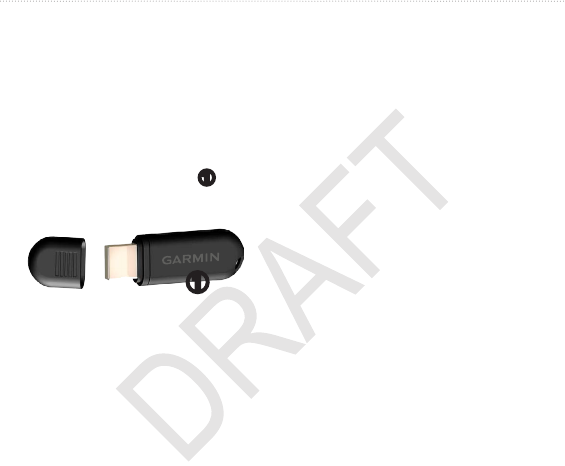
36 Forerunner x10XT Owner’s Manual
History
Before you can wirelessly send an
activity to your device, you must pair
the Forerunner with your computer
using the USB ANT Stick (page 35).
1. Plug the USB ANT Stick
➊
into a
USB port on your computer.
➊
2. Bring your device within range
(3 m) of your computer.
When the ANT Agent nds your
device, the ANT Agent displays the
unit ID and asks you if you want
to pair.
3. Select Yes.
4. Follow the on-screen instructions.
You can prevent transferring data to
or from any computer, even a paired
computer.
Select MENU > Settings > System
> Data Transfer > Data Transfer
> Off.

Forerunner x10XT Owner’s Manual 37
Navigation
Before you can view and save your
location, you must locate satellite
signals (page 9).
You can save your current location,
such as your home or parking spot.
1. Select MENU > Where To? >
Where Am I?.
Your current coordinates appear.
2. Select Save.
3. If necessary, select Edit to edit the
properties.
1. Select MENU > Where To? >
Locations.
2. Select a location.
3. Select View Location > Edit.
4. Select an attribute.
For example, select Edit Elevation
to enter a known altitude for the
location.
5. Enter the new information.
1. Select MENU > Where To? >
Locations.
2. Select a location.
3. Select Delete Location > Yes.
Before you can navigate to a saved
location, you must locate satellite
signals.
1. Select MENU > Where To? >
Locations.
2. Select a location.

38 Forerunner x10XT Owner’s Manual
Navigation
3. Select Go to Location.
The compass page appears.
To record the activity, you must start
the timer.
You can only navigate to your starting
location if you are training with GPS.
At any point during your run, you
can return to your starting point. You
must start the timer in order to use this
feature.
1. During your run, select STOP, but
do not reset the timer.
2. Select MENU > Where To? >
Back to Start.
The compass page appears. The
Forerunner navigates you back to
the starting point of your run.
Select MENU > Where To? > Stop
Navigation.
Select MENU > Settings > System
> GPS > GPS > Off.
When GPS is off, speed and distance
data are not available unless you have
an optional sensor that sends speed and
distance data to the device (such as the
foot pod or GSC 10). The next time
you turn on the device, it will search
for satellite signals again.
The satellite page shows your current
GPS satellite information. For more
information, go to www.garmin.com
/aboutGPS.
Select MENU > Settings > System >
GPS > Satellites.

Forerunner x10XT Owner’s Manual 39
Settings
Select MENU > Settings > System.
• Language—sets the device
language.
• Key Tones—sets the device to use
audible tones for key presses.
• Alert Tones—sets the device to use
audible tones for messages.
• Alert Vibration—sets the device to
use vibration for messages.
• Data Recording—controls how the
device records activity data.
◦ Smart—records key points
where you change direction,
speed, or heart rate.
◦ Every Second—records points
every second. It creates a very
detailed record of your activity;
however, it greatly increases the
size of the activity.
• GPS—page 38.
• Backlight—page 49.
You can customize units of measure
for distance, pace and speed, elevation,
position format, and weight.
1. Select MENU > Settings > System
> Units.
2. Select a setting.
3. Select a unit for the setting.

40 Forerunner x10XT Owner’s Manual
Settings
By default, the watch time is set
automatically when the Forerunner
locates satellites.
1. Select MENU > Settings > System
> Time > Set Time > Manual.
2. Enter the time.
3. If necessary, select Time Format to
choose between 12 hour or 24 hour.
1. Select MENU > Settings > Alarm.
2. Select Alarm > On.
3. Select Time, and enter a time.
Each time you locate satellites, the
device automatically detects your time
zone and the current time of day.
The Forerunner uses information that
you enter about yourself to calculate
accurate run data. You can modify the
following user prole information:
gender, age, weight, and height.
1. Select MENU > Settings > User
Prole.
2. Modify the settings.
Calorie expenditure and heart rate
analysis technology is provided and
supported by Firstbeat Technologies
Ltd. For more information, go to
www.rstbeattechnologies.com.
Training effect measures the impact
of an activity on your aerobic tness.
Training effect accumulates during
the activity. As the activity progresses
successfully, the training effect value
increases, telling you how the activity

Forerunner x10XT Owner’s Manual 41
Settings
has improved your tness. Training
effect is determined by your user
prole information, heart rate, duration,
and intensity of your activity.
It is important to know that your
training effect numbers (1.0–5.0) may
seem abnormally high during your rst
few runs. It takes several activities for
the device to learn your aerobic tness.
1.0–1.9 Helps recovery (short
activities). Improves
endurance with longer
activities (more than 40
minutes).
2.0–2.9 Maintains your aerobic
tness.
3.0–3.9 Improves your aerobic
tness if repeated as part
of your weekly training
program.
4.0–4.9 Highly improves your
aerobic tness if repeated
1–2 times per week with
adequate recovery time.
5.0 Causes temporary
overload with high
improvement. Train up to
this number with extreme
care. Requires additional
recovery days.
Training effect technology is
provided and supported by Firstbeat
Technologies Ltd. For more
information, go to
www.rstbeattechnologies.com.
You can customize the data elds on
four training pages.
1. Select MENU > Settings >
Training Pages.

42 Forerunner x10XT Owner’s Manual
Settings
2. Select a training page.
3. Select MENU.
4. Change the number of data elds
you want to see on the page.
5. Select Enabled.
6. Select ◄.
7. Select a data eld to change it.
8. Select a category and a data eld.
For example, select Heart Rate >
HR - Lap.
Data elds with the * symbol display
statute or metric units. Data elds with
the ** symbol require an ANT+ sensor.
Cadence ** For running, cadence
is measured in steps
per minute (spm).
For cycling, cadence
is measured in
revolutions of the
crank arm per minute
(rpm).
Cadence –
Average **
Average cadence for
the duration of your
current activity.
Cadence –
Lap **
Average cadence for
the current lap.
Calories Amount of total
calories burned.
Calories -
Fat
Amount of fat
calories burned.
Requires a New Leaf
®
assessment.

Forerunner x10XT Owner’s Manual 43
Settings
Calories to
Go
During a workout, the
remaining calories
when the step
duration is a calorie
amount.
Distance * Distance traveled for
the current activity.
Distance –
Lap *
Distance traveled in
the current lap.
Distance –
Last Lap *
Distance of the last
completed lap.
Distance to
Go *
During a workout, the
remaining distance
when the step
duration is a distance
amount.
Elevation * Distance above or
below sea level.
GPS
Accuracy *
The margin of
error for your exact
location. For example,
your GPS location is
accurate to within +/-
12 feet.
Grade Calculation of
rise over run. For
example, if for every
10 feet you climb
(elevation) you travel
200 feet (distance),
your grade is 5%.
Heading The direction you are
moving.
Heart Rate
**
Heart rate in beats
per minute (bpm).
Heart Rate
to Go **
During a workout,
the amount you are
above or below the
heart rate target.

44 Forerunner x10XT Owner’s Manual
Settings
HR – %HRR
**
Percentage of
heart rate reserve
(maximum heart rate
minus resting heart
rate).
HR – %Max.
**
Percentage of
maximum heart rate.
HR –
Average **
Average heart rate for
the duration of your
current activity.
HR – Avg.
%HRR **
Average percentage
of heart rate reserve
(maximum heart rate
minus resting heart
rate) for the activity.
HR – Avg.
%Max. **
Average percentage
of maximum heart
rate for the activity.
HR – Lap ** Average heart rate in
the current lap.
HR – Lap
%HRR **
Average percentage
of heart rate reserve
(maximum heart rate
minus resting heart
rate) for the lap.
HR – Lap
%Max. **
Average percentage
of maximum heart
rate for the lap.
HR Zone ** Current range of
heart rate (1 to 5).
The default zones are
based on your user
prole, maximum
heart rate, and resting
heart rate.
Lap Pace
Zone
Range of pace (ten
zones available) for
the current lap.
Lap Speed
Zone *
Range of speed (ten
zones available) for
the current lap.

Forerunner x10XT Owner’s Manual 45
Settings
Laps Number of laps
completed.
Pace Current pace.
Pace –
Average
Average pace for
the duration of your
current activity.
Pace – Lap Average pace in the
current lap.
Pace – Last
Lap
Average pace during
the last completed
lap.
Pace Zone Current range of
pace. Zones can
be set in Garmin
Connect.
Reps to Go During a workout, the
remaining repetitions.
Speed * Current speed.
Speed –
Average *
Average speed for the
activity.
Speed –
Lap *
Average speed in the
current lap.
Speed –
Last
Lap *
Average speed during
the last completed
lap.
Speed
Zone *
Current range of
speed. Zones can
be set in Garmin
Connect.
Sunrise The time of sunrise
based on your GPS
position.
Sunset The time of sunset
based on your GPS
position.
Time Stopwatch time.
Time – Avg.
Lap
Average time to
complete the laps
so far.

46 Forerunner x10XT Owner’s Manual
Settings
Time -
Elapsed
Total time recorded.
For example, if you
run 10 minutes, then
stop the timer for 5
minutes, then start the
timer again and run
for 20 minutes, your
elapsed time is 35
minutes.
Time – Lap Amount of time in the
current lap.
Time – Last
Lap
Amount of time during
the last completed
lap.
Time of Day Current time of day
based on your time
settings (format, time
zone, and daylight
saving time).
Time to Go During a workout, the
remaining time in the
interval or step.
Training
Effect (TE)
**
Current impact (1.0-
5.0) on your aerobic
tness (page 40).
1. Select MENU > Settings >
Training Pages.
2. Select a training page.
3. Select a data eld to change it.
4. Select Favorites > Edit Favorites.
5. Select one or more data elds.
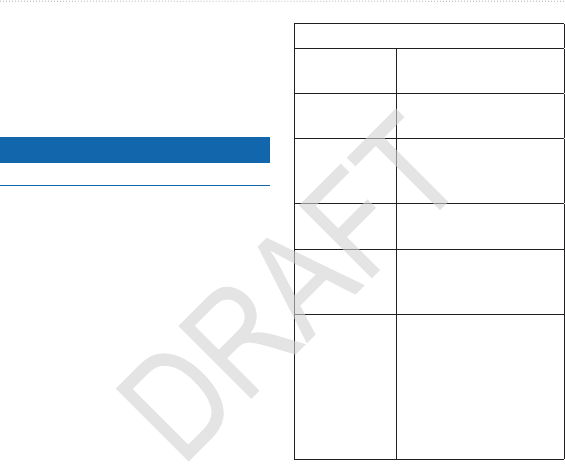
Forerunner x10XT Owner’s Manual 47
Device Information
notice
The Forerunner is
NOTE: swimming note or notice.
Battery 200 mAh rechargeable,
lithium-ion battery
Battery life 20 hours, typical use
(xref)
Operating
temperature
range
From -4°F to 140°F
(from -20°C to 60°C)
Water
resistance
164 ft. (50 m)
Radio
frequency/
protocol
2.4 GHz ANT+ wireless
communications
protocol
Compatible
accessories
ANT+ wireless
technology works
with compatible heart
rate monitor, foot
pod, GSC 10, power?
weight scale, and
tness equipment.
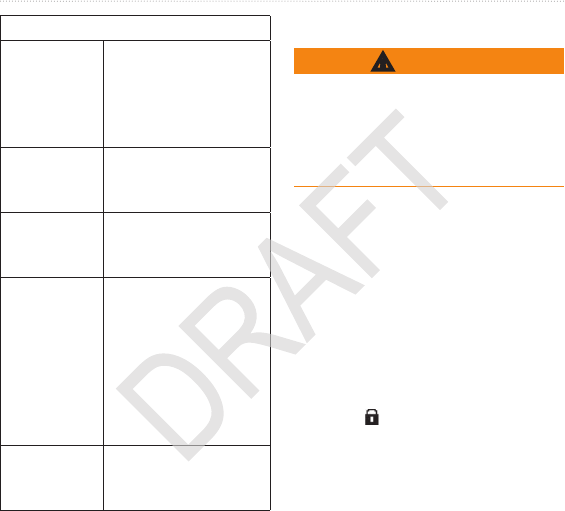
48 Forerunner x10XT Owner’s Manual
Device Information
Water
resistance
98.4 ft. (30 m)
This product does not
transmit heart rate data
to your GPS device
while swimming.
Battery User-replaceable
CR2032, 3 volts (page
49)
Battery life Approximately 4.5
years
(1 hour per day)
Operating
temperature
From 23°F to 122°F
(from -5°C to 50°C)
: In cold
conditions, wear
appropriate clothing
to keep the heart rate
monitor near your body
temperature.
Radio
frequency/
protocol
2.4 GHz ANT+ wireless
communications
protocol
This product contains a lithium-ion
battery. See the Important Safety and
Product Information guide in the
product box for product warnings and
other important information.
The actual battery life of a fully
charged battery depends on how much
time you use GPS, the backlight,
and power save mode. Exposure to
extremely cold temperatures will also
reduce battery life.
After a period of inactivity, the
Forerunner goes into power save
mode and appears. The Forerunner
displays the time and date, but does not
connect with your ANT+ accessories
or use GPS. Swipe left to exit power
save mode.
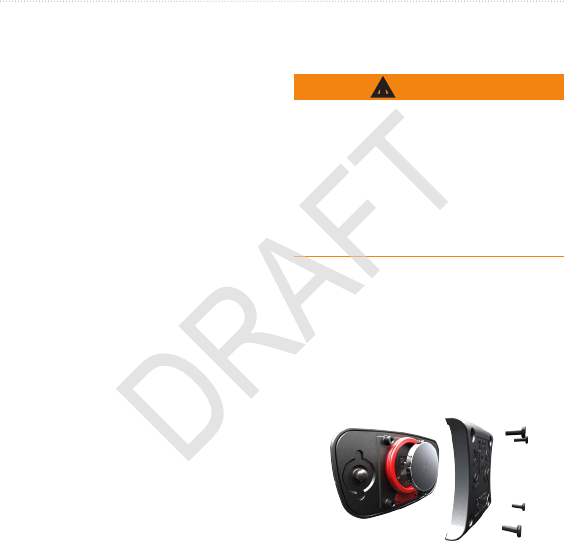
Forerunner x10XT Owner’s Manual 49
Device Information
Extensive use of screen backlighting
can signicantly reduce battery life.
1. Select MENU > Settings > System
> Backlight > Mode.
2. Select an option:
• To activate the backlight only
using the LIGHT key, select
Manual.
• To activate the backlight for all
key presses and messages, select
Keys/Alerts.
1. Select MENU > Settings > System
> Backlight > Timeout.
2. Select a short backlight timeout.
Do not use a sharp object to remove
user-replaceable batteries. Contact
your local waste disposal department
to properly recycle the batteries.
Perchlorate Material – special handling
may apply. See www.dtsc.ca.gov
/hazardouswaste/perchlorate.
1. Use a small Phillips screwdriver to
remove the four screws on the back
of the module.
2. Remove the cover and battery.
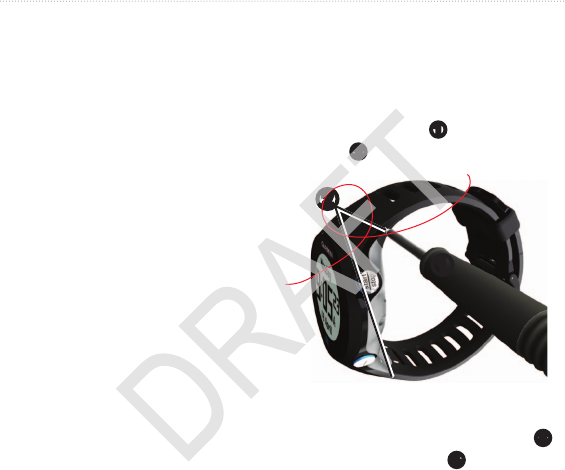
50 Forerunner x10XT Owner’s Manual
Device Information
3. Wait 30 seconds.
4. Insert the new battery with the
positive side facing up.
NOTE: Do not damage or lose the
O-ring gasket.
5. Replace the back cover and the four
screws.
After you replace the heart rate monitor
battery, you must pair it with the device
again.
You can purchase a fabric wrist band
accessory for the Forerunner
(http://buy.garmin.com).
1. Use the pin tool
➊
to remove the
pins
➋
.
➊
➋
NOTE: Do not discard the pins.
2. Align the top of the Forerunner
➌
with the connector
➍
.
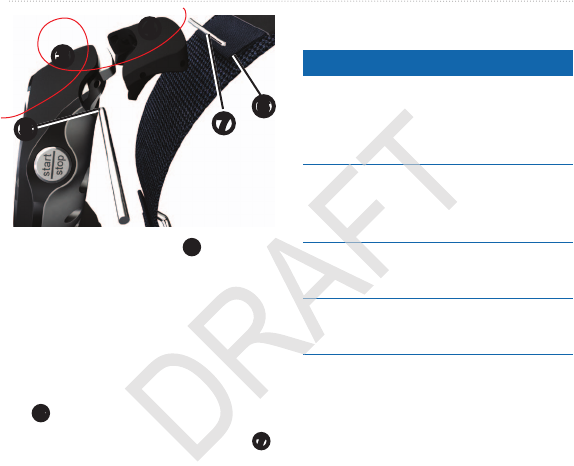
Forerunner x10XT Owner’s Manual 51
Device Information
➌
➐
➍
➎
➏
3. Insert the tapered end
➎
of the
pin to secure the connector to the
Forerunner.
TIP: You must rmly press the pin
into the connector. Use a sturdy,
blunt object, if necessary.
4. Align the connector with the loop
➏
of the fabric wrist strap.
5. Insert the tapered end of the pin
➐
to secure the connector to the loop.
6. Repeat steps 2–5 for the bottom
connector.
notice
Do not store the device where
prolonged exposure to extreme
temperatures can occur, because it can
cause permanent damage.
Never use a hard or sharp object to
operate the touchscreen, or damage
may result.
Do not use a sharp object to clean the
area between the screen and bezel.
Avoid chemical cleaners and solvents
that can damage plastic components.
1. Use a cloth dampened with a mild
detergent solution.
2. Wipe it dry.

52 Forerunner x10XT Owner’s Manual
Device Information
1. Use a soft, clean, lint-free cloth.
2. If necessary, use water, isopropyl
alcohol, or eyeglass lens cleaner.
3. Apply the liquid to the cloth, and
gently wipe the screen with the
cloth.
You must unsnap the module before
cleaning the strap.
• Rinse the strap after every use.
• Hand wash the strap in cold water
with a mild detergent after every
ve uses.
• Do not put the strap in a washing
machine or a dryer.
• To prolong the life of your heart
rate monitor, unsnap the module
when not in use.
Before you can update the device
software, you must pair the USB ANT
Stick with your computer (page 36).
1. Connect the USB ANT Stick to
your computer.
2. Go to www.garminconnect.com.
If there is new software available,
Garmin Connect alerts you to
update the software.
3. Follow the on-screen instructions.
4. Keep your device in range (3 m)
of the computer during the update
process.

Forerunner x10XT Owner’s Manual 53
Device Information

54 Forerunner x10XT Owner’s Manual
Device Information

Forerunner x10XT Owner’s Manual 55
Appendix
Contacting Garmin Product
Support..................................... 64
Registering Your Device.............. 64
Buying Accessories..................... 64
(move) Data Field
Options...................... 67
Troubleshooting...

56 Forerunner x10XT Owner’s Manual
Appendix

Forerunner x10XT Owner’s Manual 57
Index
accessories 5, 22–26, 48
alarm 36
alerts 9–10
tones and vibrations 35
ANT+
tness equipment 27
foot pod 25
heart rate monitor 23
pairing 22
troubleshooting 29
weight scale 27
Auto Lap 11–12
Auto Pause 12
auto scroll 12
backlight 46
back to start 34
battery
charging 5, 6, 46
Forerunner 45
heart rate monitor 47
bike sensors 26
cadence
alerts 10
data elds 38
GSC 10 26
calibrating
bike sensors 26
foot pod 25–26
calorie
alerts 9
data elds 38
expenditure 36
caring for your devices 49
charging 46
coordinates 33
countdown timer 19
custom workouts 16
data elds 38–41
data recording 35
deleting
custom workout 18
history 31
locations 33
distance
alerts 9
data elds 39
elevation
data elds 39
location 33
tness equipment 27
foot pod 25, 25–26
Garmin Connect 18, 31
Garmin Training Center
18, 31
GPS
accuracy 39
satellite signals 34
settings 36
grade 39
GSC 10 26
heart rate

58 Forerunner x10XT Owner’s Manual
Index
alerts 10
data elds 39–40
zones 23–24
heart rate monitor
battery 47
cleaning 49
pairing 22
specications 44
history
deleting 31
transferring 32
viewing 30
interval workouts 14
keys
tones 35
language 35
lap 7
lifetime athlete 27
lithium-ion battery 5,
43, 45
locating satellite signals
locations 33
marking your location 33
navigating
back to start 34
to locations 33
New Leaf 38
pace 9, 30, 41
pairing ANT+ sensors 22
pausing an activity 12
power save 45
prole 36
registering your device 5
resetting
history totals 31
satellite signals 34
saving
locations 33
your activity 9
scale 27
sensors 22–29
smart recording 35
software 5, 31
specications 43–44
speed 9, 30, 41
speed source 25
sport mode 8
storing the device 49
swimming 43
time
alerts 9
data elds 41
format 36
setting the watch 36
zones 36
tones
alerts 35
keys 35
touchscreen
cleaning 49

Forerunner x10XT Owner’s Manual 59
Index
Training Effect 42
transferring
history 32
troubleshooting
ANT+ accessories 29
units 35
updating the software 5
user prole 36
vibration
alerts 35
Virtual Partner 13
Virtual Racer 13, 14
walking breaks 10
water resistance 43–44
weight scale 27
workouts
custom 16
interval 14
wrist band 48

Garmin International, Inc.
1200 East 151st Street,
Olathe, Kansas 66062, USA
Garmin (Europe) Ltd.
Liberty House, Hounsdown Business Park
Southampton, Hampshire, SO40 9LR UK
Garmin Corporation
No. 68, Zhangshu 2nd Road, Xizhi Dist.
New Taipei City, 221, Taiwan (R.O.C.)
www.garmin.com/support
© 2011 Garmin Ltd. or its subsidiaries
www.garmin.com
00 358 19 311 001
00 33 1 5517 81 89
0180 5 / 42 76 46 - 880
0180 5 / 42 76 46 - 550
00 39 02 3669 9699
0800-0233937
815 69 555
00800 4412 454
+44 2380 662 915
00 35 1214 447 460
00 46 7744 52020
00 902 00 70 97
43 (0) 3133 3181 0
00 32 2672 5254
1-866-429-9296
00 45 4810 5050
913-397-8200
1-800-800-1020
0808 2380000
+44 (0) 870.8501241